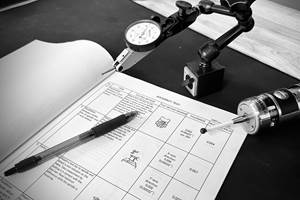Measurement for True Surface Analysis
Optical metrology is providing more information, faster, about surfaces that were once impossible to measure and understand.
Share




When an engineer includes a surface finish specification on a print, the intent is usually not just for aesthetics. Surface finish affects how a part will fit, wear, reflect light, transmit heat, distribute lubrication and accept coatings. The finish should be determined by the part's function: A surface should fulfill the engineering requirements of the application without wasting time and effort on a higher quality finish than necessary. In fact, many applications do better with a certain amount of "texture," and too fine of a finish can be just as bad as too coarse of a finish.
In the 1940s, the surface finish measurement upgraded from visually comparing patch reference standards to moving a fine stylus across a part’s surface via a transducer and amplifier. This provided part measurement data that could be recorded and analyzed against various surface parameters to evaluate its roughness, profile and waviness.
For the next half century, this technique was invaluable to various industries: It helped engines last longer, improved fuel economy, made aircraft safer and offered a host of other improvements in manufacturing. The benefits were valuable industry wide but also to the user, who could obtain results with low-cost, simple-to-operate, portable systems that could be used at the point of manufacture by the machine tool operator.
Measurement results were 2D, meaning that surfaces were analyzed for roughness along a single line, and thus, only a small sample of the surface was actually being inspected. Systems that are more complex would create 3D-surface-area results by combining multiple traces, but there was still a lot of important surface information that could be missed with this mechanical measurement. The key limitation of these systems was that the technique was often limited to parts or structures that were visible and regular (homogeneous) in their surface pattern.
However, there are many surface applications in which a tactile probe may not work. This can include very small surfaces; materials that are very delicate and could be damaged when touched with a probe; surfaces that are coated or irregular (inhomogeneous) in their pattern; or surfaces that are porous, such as ceramics or castings.
As a result, metrology is going through a revolution with a completely new industry developed around optics for true surface analysis.
Moving beyond form, waviness and roughness, optical 2D and 3D analysis now allows for grain structure, lattice and molecular structures on surfaces that were either too small or too delicate for other means of analysis. New surface analysis techniques are being provided by optical technologies using vision, confocal image analysis and interferometry.
Small or sensitive surfaces can be measured using optical 2D profile analysis similar to contact systems with excellent correlation to tactile techniques. These systems can be faster than contact systems and enable profiling of small areas of the surface in an X-Y pattern to create patches for structure analysis. These small patches are often connected (stitched) together to create a larger picture of the sample’s surface. Thus, the combination of these small patches and the system’s longer measuring ranges enable large parts such as bone screws, semiconductors, printing rolls or even portions of an engine block to be inspected and analyzed quickly and accurately with a non-contact surface system and better tools for analyzing the results.
Alternatively, fine images of the surface can be taken and combined in the same manner to produce high-resolution pictures of the surface for analysis.
Because the technology has moved to 3D, ISO 25178 and ASME B46.1 created new areal parameters to standardize the results from these measuring techniques. These include:
- Hybrid Parameters – These values involve both height and spatial dimensions in which vertical and horizontal information are combined to provide angle and slope information of the surface.
- Spatial Parameters – These quantify how much and how often the surface features repeat themselves and whether a surface would have varying results when measured in different directions.
- Structure Parameters – These describe functional structures such as grooves for lubricate transport or storage.
The rapidly changing technology is providing more information, faster, about surfaces that were once impossible to measure and understand. These new tools improve the manufacturing and inspection process for the automotive, medical, electronics and other industries.
Related Content
How to Calibrate Gages and Certify Calibration Programs
Tips for establishing and maintaining a regular gage calibration program.
Read MoreThe Link Between CNC Process Control and Powertrain Warranties
Ever since inventing the touch-trigger probe in 1972, Sir David McMurtry and his company Renishaw have been focused on achieving process control over its own manufacturing operations. That journey has had sweeping consequences for manufacturing at large.
Read More4 Ways to Establish Machine Accuracy
Understanding all the things that contribute to a machine’s full potential accuracy will inform what to prioritize when fine-tuning the machine.
Read MoreTurning Fixed-Body Plug Gages Inside Out
Fixed-body mechanical plug gages provide fast, high-performance measurement for tight-tolerance holes.
Read MoreRead Next
Setting Up the Building Blocks for a Digital Factory
Woodward Inc. spent over a year developing an API to connect machines to its digital factory. Caron Engineering’s MiConnect has cut most of this process while also granting the shop greater access to machine information.
Read MoreRegistration Now Open for the Precision Machining Technology Show (PMTS) 2025
The precision machining industry’s premier event returns to Cleveland, OH, April 1-3.
Read MoreBuilding Out a Foundation for Student Machinists
Autodesk and Haas have teamed up to produce an introductory course for students that covers the basics of CAD, CAM and CNC while providing them with a portfolio part.
Read More































